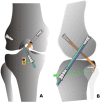Posterior cruciate ligament reconstruction using PCL inlay technique with the patient supine in bicruciate ligament injury reconstruction
- PMID: 36609270
- PMCID: PMC9817398
- DOI: 10.1186/s13018-022-03495-6
Posterior cruciate ligament reconstruction using PCL inlay technique with the patient supine in bicruciate ligament injury reconstruction
Abstract
Background: Surgical reconstruction of the posterior cruciate ligament (PCL) can be technically challenging given the proximity of the popliteal artery to the PCL tibial insertion. This "no-safe zone" makes some knee surgeons less confident and willing to perform this surgical procedure.
Surgical technique: We present a PCL tibial inlay reconstruction technique using a set of instruments involving three tools (a slot cut, a bone plug positioner, and an impactor).
Conclusion: This set of instruments allows a more reproducible posteromedial approach and to produce a PCL tibial slot in a posterior cruciate ligament inlay reconstruction with the patient supine in bicruciate ligament injury reconstruction.
Keywords: Posterior cruciate ligament injuries; Posterior cruciate ligament reconstruction; Surgical instruments; Surgical procedures, operative.
© 2023. The Author(s).
Conflict of interest statement
Prof. Nicola Maffulli is Editor in Chief of the Journal of Orthopaedic Surgery and Research.
Figures











References
-
- Badet R, Demey G, Piedade SR. Reconstruction du ligament croise postérieur. In: Arthroscopie L, editor. Principes, objectifs et tunnelisation. 3. Paris: Elsevier; 2015. pp. 1047–1056.
-
- Badet R, Verdonk P, Piedade SR. Technique in PCL reconstruction: mini posterior approach. In: Bonin M, Amendola A, Bellemans J, MacDonald S, Menetrey J, editors. The knee joint. Surgical: techniques and strategies. Paris: Springer; 2012. pp. 411–415.
-
- Piedade SR, Mischan MM, Knee PCL. reconstruction: a tibial bed fixation (“inlay”) technique objective and subjective evaluation of a 30-cases series. Acta Ortop Bras. 2006;14(2):92–96. doi: 10.1590/S1413-78522006000200007. - DOI
MeSH terms
LinkOut - more resources
Full Text Sources

